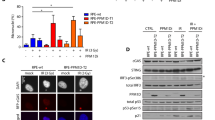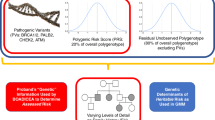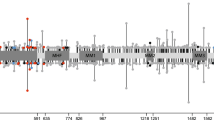Abstract
Mosaic protein truncating variants (PTVs) in the phosphatase, Mg2+/Mn2+dependent 1D (PPM1D) gene in blood-derived DNA have been associated with increased risk of breast cancer. We analyzed PPM1D PTVs in blood from 3817 breast cancer cases and 3058 controls by deep sequencing of a previously defined region in exon 6 of PPM1D. We identified 50 of 6875 (0.73%) participants having a mosaic PPM1D PTV. We observed a higher frequency of mosaic PPM1D PTVs with increasing age (Ptrend = 2.9 × 10−6). We did not observe an overall association between PPM1D PTVs and increased breast cancer risk (OR = 1.51, 95% CI = 0.84–2.71). Evidence for an association was observed in a subset of cases with DNA collected 1-year or more before breast cancer diagnosis (OR = 3.44, 95% CI = 1.62–7.30, P-value = 0.001); however, no significant association was observed for the larger series of cases with DNA collected post diagnosis (OR = 1.01, 95% CI = 0.51–2.01, P-value = 0.98). Our study indicates that the PPM1D PTVs are present at higher rates than previously reported and the frequency of PPM1D PTVs increases with age. We observed limited evidence for an association between mosaic PPM1D PTVs and breast cancer risk, suggesting mosaic PPM1D PTVs in the blood likely do not influence risk of breast cancer.
Similar content being viewed by others
Log in or create a free account to read this content
Gain free access to this article, as well as selected content from this journal and more on nature.com
or
References
Lu X, Nguyen TA, Moon SH, Darlington Y, Sommer M, Donehower LA. The type 2C phosphatase Wip1: an oncogenic regulator of tumor suppressor and DNA damage response pathways. Cancer Metastas Rev. 2008;27:123–35.
Fiscella M, Zhang H, Fan S, Sakaguchi K, Shen S, Mercer WE, et al. Wip1, a novel human protein phosphatase that is induced in response to ionizing radiation in a p53-dependent manner. Proc Natl Acad Sci USA. 1997;94:6048–53.
Takekawa M, Adachi M, Nakahata A, Nakayama I, Itoh F, Tsukuda H, et al. p53-inducible wip1 phosphatase mediates a negative feedback regulation of p38 MAPK-p53 signaling in response to UV radiation. EMBO J. 2000;19:6517–26.
Cancer Genome Atlas, N. Comprehensive molecular portraits of human breast tumours. Nature. 2012;490:61–70.
Li J, Yang Y, Peng Y, Austin RJ, van Eyndhoven WG, Nguyen KC, et al. Oncogenic properties of PPM1D located within a breast cancer amplification epicenter at 17q23. Nat Genet. 2002;31:133–4.
Ruark E, Snape K, Humburg P, Loveday C, Bajrami I, Brough R, et al. Mosaic PPM1D mutations are associated with predisposition to breast and ovarian cancer. Nature. 2013;493:406–10.
Zajkowicz A, Butkiewicz D, Drosik A, Giglok M, Suwinski R, Rusin M. Truncating mutations of PPM1D are found in blood DNA samples of lung cancer patients. Br J Cancer. 2015;112:1114–20.
Pharoah PDP, Song H, Dicks E, Intermaggio MP, Harrington P, Baynes C, et al. PPM1D mosaic truncating variants in ovarian cancer cases may be treatment-related somatic mutations. J Natl Cancer Inst. 2016;108.
Akbari MR, Lepage P, Rosen B, McLaughlin J, Risch H, Minden M, et al. PPM1D mutations in circulating white blood cells and the risk for ovarian cancer. J Natl Cancer Inst. 2014;106:djt323.
Swisher EM, Harrell MI, Norquist BM, Walsh T, Brady M, Lee M, et al. Somatic mosaic mutations in PPM1D and TP53 in the blood of women with ovarian carcinoma. JAMA Oncol. 2016;2:370–2.
Cardoso M, Paulo P, Maia S, Teixeira MR. Truncating and missense PPM1D mutations in early-onset and/or familial/hereditary prostate cancer patients. Genes Chromosomes Cancer. 2016;55:954–61.
Kleiblova P, Shaltiel IA, Benada J, Sevcik J, Pechackova S, Pohlreich P, et al. Gain-of-function mutations of PPM1D/Wip1 impair the p53-dependent G1 checkpoint. J Cell Biol. 2013;201:511–21.
Garcia-Closas M, Brinton LA, Lissowska J, Chatterjee N, Peplonska B, Anderson WF, et al. Established breast cancer risk factors by clinically important tumour characteristics. Br J Cancer. 2006;95:123–9.
Gohagan JK, Prorok PC, Kramer BS, Hayes RB, Cornett JE. The prostate, lung, colorectal, and ovarian cancer screening trial of the national cancer institute. Cancer. 1995;75:1869–73.
Fisher S, Barry A, Abreu J, Minie B, Nolan J, Delorey TM, et al. A scalable, fully automated process for construction of sequence-ready human exome targeted capture libraries. Genome Biol. 2011;12:R1.
Lange V, Bohme I, Hofmann J, Lang K, Sauter J, Schone B, et al. Cost-efficient high-throughput HLA typing by MiSeq amplicon sequencing. BMC Genom. 2014;15:63.
Jacobs KB, Yeager M, Zhou W, Wacholder S, Wang Z, Rodriguez-Santiago B, et al. Detectable clonal mosaicism and its relationship to aging and cancer. Nat Genet. 2012;44:651–8.
Laurie CC, Laurie CA, Rice K, Doheny KF, Zelnick LR, McHugh CP, et al. Detectable clonal mosaicism from birth to old age and its relationship to cancer. Nat Genet. 2012;44:642–50.
Machiela MJ, Zhou W, Sampson JN, Dean MC, Jacobs KB, Black A, et al. Characterization of large structural genetic mosaicism in human autosomes. Am J Hum Genet. 2015;96:487–97.
Machiela MJ, Zhou W, Karlins E, Sampson JN, Freedman ND, Yang Q, et al. Female chromosome X mosaicism is age-related and preferentially affects the inactivated X chromosome. Nat Commun. 2016;7:11843.
Zhou W, Machiela MJ, Freedman ND, Rothman N, Malats N, Dagnall C, et al. Mosaic loss of chromosome Y is associated with common variation near TCL1A. Nat Genet. 2016;48:563–8.
Forsberg LA, Rasi C, Malmqvist N, Davies H, Pasupulati S, Pakalapati G, et al. Mosaic loss of chromosome Y in peripheral blood is associated with shorter survival and higher risk of cancer. Nat Genet. 2014;46:624–8.
Xie M, Lu C, Wang J, McLellan MD, Johnson KJ, Wendl MC, et al. Age-related mutations associated with clonal hematopoietic expansion and malignancies. Nat Med. 2014;20:1472–8.
Genovese G, Kahler AK, Handsaker RE, Lindberg J, Rose SA, Bakhoum SF, et al. Clonal hematopoiesis and blood-cancer risk inferred from blood DNA sequence. N Engl J Med. 2014;371:2477–87.
Jaiswal S, Fontanillas P, Flannick J, Manning A, Grauman PV, Mar BG, et al. Age-related clonal hematopoiesis associated with adverse outcomes. N Engl J Med. 2014;371:2488–98.
Acknowledgements
We thank Nazneen Rahman and her lab for providing technological assistance and positive control samples. Special thanks to the women in PBCS and PLCO for contributing samples for this project.
Funding
This research was funded by the National Institutes of Health Intramural Research Program.
Author information
Authors and Affiliations
Contributions
MJM, TAM, MG and SJC participated in the design of the study. MJM, TAM, CJH, RK, WDF, LMC, LJ, TUA, NDF, MG and SJC were involved in the collection, analysis and interpretation of the data. MJM, TAM and SJC drafted the manuscript. All authors approved the final manuscript for submission.
Corresponding author
Ethics declarations
Conflict of interest
The authors declare that they have no conflict of interest.
Additional information
Publisher’s note: Springer Nature remains neutral with regard to jurisdictional claims in published maps and institutional affiliations.
Supplementary information
Rights and permissions
About this article
Cite this article
Machiela, M.J., Myers, T.A., Lyons, C.J. et al. Detectible mosaic truncating PPM1D mutations, age and breast cancer risk. J Hum Genet 64, 545–550 (2019). https://doi.org/10.1038/s10038-019-0589-1
Received:
Accepted:
Published:
Issue date:
DOI: https://doi.org/10.1038/s10038-019-0589-1
This article is cited by
-
Large-scale analysis of acquired chromosomal alterations in non-tumor samples from patients with cancer
Nature Biotechnology (2020)



